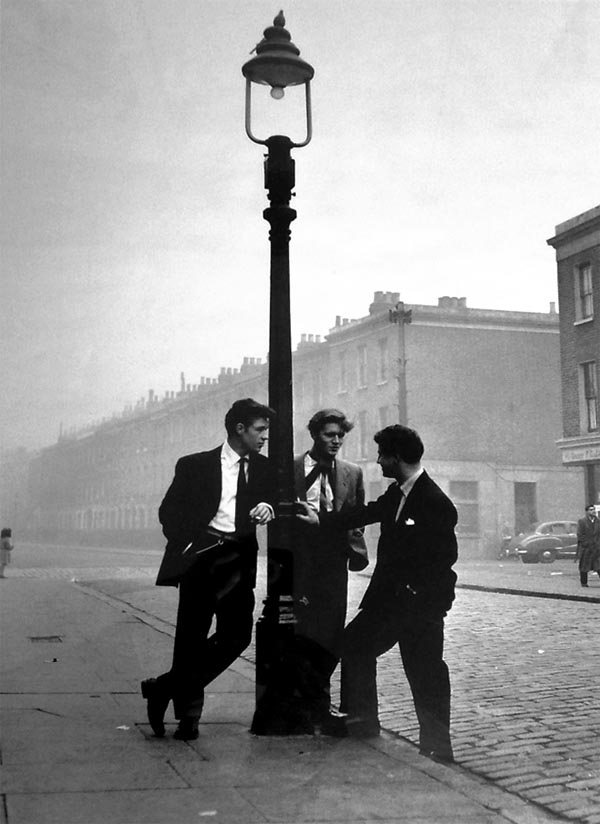 |
Elm Works Parade Lantern
Genre: Open Type Conical Lantern
The open type conical lantern was on the first types of specialised street lighting lanterns
developed with early examples appearing in the 1900s or even possibly earlier. The design of
the distinctive conical reflector was designed to create a symmetric distribution in plan
with flux reflected at high angles to increase the illumination at distances from the lantern
and hence increase the space-height ratio required.
Whilst the theory was sound, many manufacturers elected to use white stove-enamelled steel-spun
over-reflectors. Unless extremely highly polished, these reflectors exhibited little specular
reflection as required by their design, and instead acted as diffusers. The result was a reutilisation
of some of the flux emitted in the upper hemisphere by the lamp but not at the required
high angles to achieve uniform illumination.
Therefore the lantern type was quickly discredited by many theorists and lighting designers
but to little avail. Local authorities looking for a cheap lighting solution installed this
lantern type in huge numbers, even after more scientifically proved lanterns with suitably
placed reflectors and refractors began to appear. The symmetric distribution was
also particularly suited for residential areas where a wide symmetric illumination was
particularly preferred.
It was kept on manufacturer's catalogues up until the 1950s when finally the specifications
caught up and required the lamps to be enclosed. But the lanterns themselves proved to be
remarkably durable – despite the rust problems of the thin spun steel reflectors – and many
were still in service during the 1980s and 1990s.

Name: Elm Works Parade
Date: Circa 1950s
Dimensions: Width: 14", Height: 36"
Light Distibution: Uniform Distribution
Lamp: 60-200W GLS

|
History
I initially thought this lantern was a home-made bodge of a harp-bracket and gas lamp canopy.
However, the chance discovery of the pictures of the Teddy Boys in Notting Hill, London in 1954 (left)
shows the same type lantern in-situ.
Therefore I believe the lantern was manufactured as a cheap gas-to-electricity conversion
in the 1950s and utilised spare gas lamp canopies from redundant or cheap stock.
Identification
The lantern is easily identified in pictures thanks to its unique appearance. However, there
are no manufacturing names or numbers on the body of the frame or the brass canopy.
Popularity
It was an extremely rare lantern. The only documentary evidence that it was
a street lighting lantern is from the Notting Hill pictures and the example in my collection.
Optical System
The lantern used a conical shaped over-reflector to redirect flux emitted above the horizontal.
The intention was to focus the flux at a high-angle symmetrically around the lantern and therefore
increase the range of the minimum illumination striking the road or path surface. In reality the
enamel surface acted as a diffuser and the flux was redistributed at all angles – whilst this ensured
that the lantern’s reflector appeared bright at all viewing angles, it meant that claims of the
lantern's efficiency were over-stated.
|

The Elm Works Parade Lantern In My Collection

|
|
facing profile
I purchased this lantern from one of the stable antique shops in Camden Market in 1994.
The frame was originally painted white and the canopy was dull with corrosion.
The seller didn’t know anything about its history.
|
|

|
|
front profile
It’s fanciful to suggest that this was a survivor from the Notting Hill
installation given the proximity of Camden Market.
|
|

|
|
trailing profile
The lantern was extensively restored and repainted silver. All screws were
replaced and many of the holes in the frame required retapping. Finally the
canopy was polished although this was just a cosmetic move on my part – the
original installation would’ve probably been painted.
|
|

|
|
canopy
The brass canopy was from an old gas lamp and included an inspection cover. It was made
from three separate brass spinnings which were screwed together. The finial was held
in place by three metal straps. One was missing and had to be replaced and this gave
the finial a jaunty angle – this same problem can be seen in the pictures of the Notting Hill example.
|
|

|
|
inspection cover
The inspection cover was now redundant and didn't serve any obvious function. Access to the
fixed lampholder could be achieved by simply unscrewing the four screws around the circumference
of the bracket top.
|
|

|
|
pedestrian view
This view shows how simple the optical system of this lantern was. The flux was
simply redistributed symmetrically around the lantern – there was little light
control at all.
|
|



